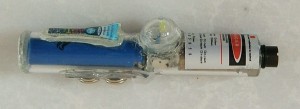Red Burning Laser
After getting interested in laser diodes, I started looking into buying high power red laser diodes. Initially, I obtained the diodes by extracting them from old DVD R/W drives. Unfortunately, this extraction process (while yielding some nice optics) was largely wasteful, and just the process of extracting the diode could damage it. Furthermore, these drives were hard to come by unless new ones were bought, and that buying new ones seemed very wasteful. As a result, I transitioned to buying diodes from online sources (especially eBay). These diodes were expensive, and I probably broke about 9 for every 10 I bought.
Having successfully obtained some diodes, I then needed to find a driving circuit. My dad helped me develop a constant-current circuit based around two transistors. This turned out to work nicely, so I built the circuit, placed the laser diode and driver circuit in an Aixis module, and attached wires to the driver to outside the module. This was the basis for a simple laser diode module that would provide somewhat regulated output for a variety of input voltages.
Finally, the module was attached to a lighted DPDT latching switch and Li-Ion cell, then enclosed inside a large plastic tube.
As you can see, the final product has (from left to right): an adjustable focusing lens, the laser module (with standard safety warning), the DPDT switch, the Li-Ion (and product label), and back magnet.
So how well does it fare in terms of burning capabilities?
It seems to be able to pop a balloon from a far distance.
…And it can also light matches. Good enough for me!
Actually, in this video, I spent a while trying to set everything up (including the green laser) to demonstrate their abilities. The green laser is pointed at a MEMS device (used for DLP TVs), which diffracts and reflects the laser, causing the diffraction pattern seen on the backing. In order to light the match, I stood behind the structure and pulled a tiny string that moved the match in front of the laser’s beam.
The final specs are:
- Color: Red
- Wavelength: 658nm
- Power Output: < 200mW
Bright Green Laser
After experimenting with high power red laser diodes, I started getting interested in laser diodes of other wavelengths. I figured the next logical step would be to go on to green lasers (as opposed to high power infrared lasers). Most green lasers are DPSS (diode-pumped solid state) lasers. An 808nm IR laser diode gets converted to even deeper 1064nm IR via Nd:YVO4, then is doubled to 532nm green laser light (plus some leaking IR) via a KTP crystal. Unfortunately, as aligning the crystals is extremely difficult, this process was a bit beyond my building capabilities, so I just bought a pre-built green laser module.
Then, as with the Red module, I soldered the module to a DPDT Latching switch and a 10440 Li-Ion cell.
Finally, the clear case and labels were added to arrive at the finished product.
You can see the light output of this laser in one of my videos above. Also, the hole in the top of the case allows access to the potentiometer on the IR LD driver circuit (which controls the input power to the laser diode).
The final specs are:
- Color: Green
- Wavelength: 532nm
- Power Output: < 20mW



